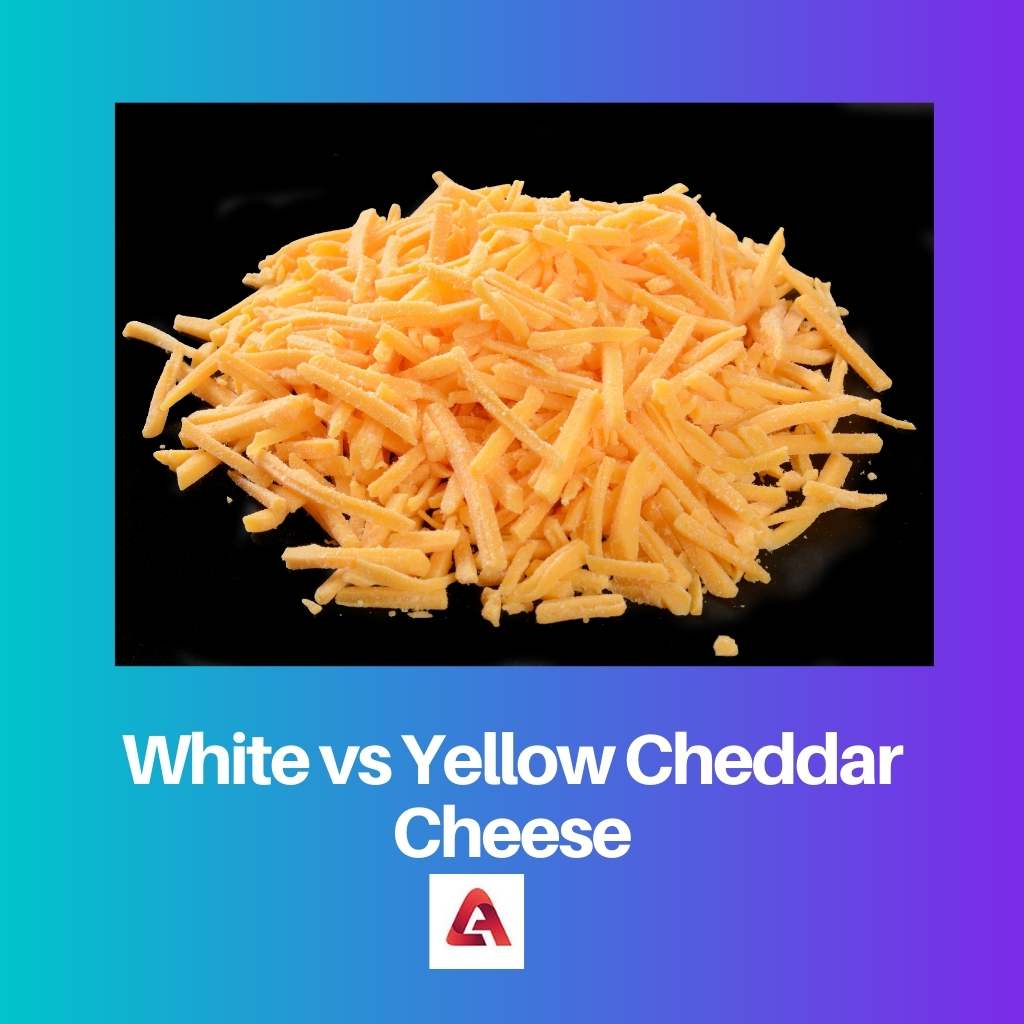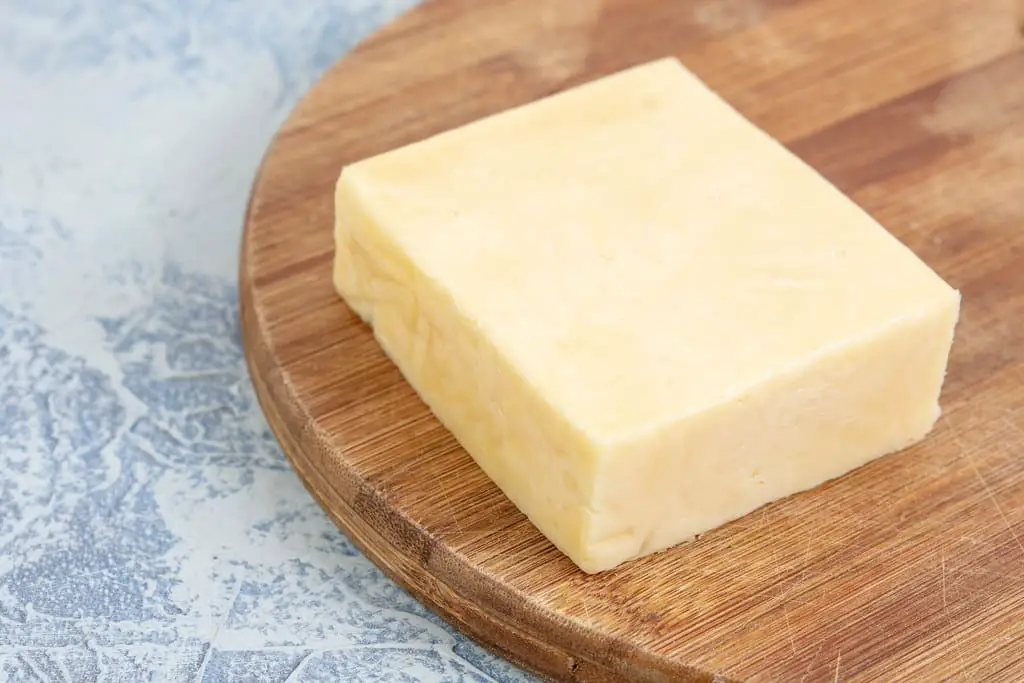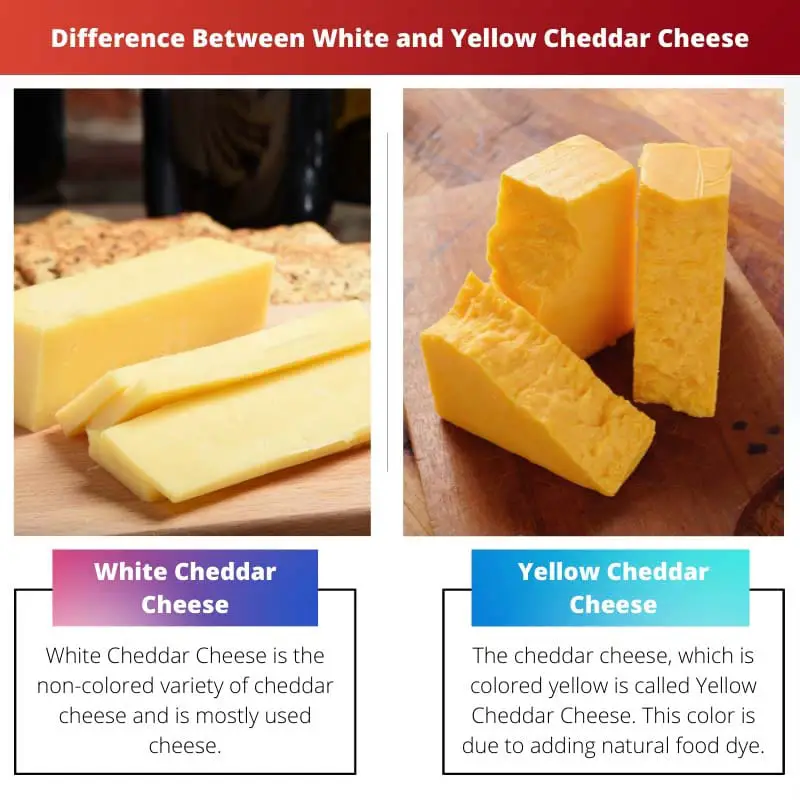Dairy Products are excellent derivatives of calcium tablets and other nutrient supplements. Dairy items are made from the milk of milk-producing animals like camels, sheep, buffalo, cows, etc.
Dairy foods include yoghurt, cheese, butter, cream, etc. Dairy foods are easily available throughout the world.
Cheese is a famous dairy item produced everywhere in many different varieties. The most popular cheeses include mozzarella, cheddar, gouda, etc.
Cheddar Cheese is a semi-hard off-white natural cheese and has different types like mild cheddar cheese, sharp or extra sharp cheddar cheese, white cheddar cheese, etc.
Key Takeaways
- White cheddar cheese is made from white milk, while yellow cheese is made from milk with added annatto seed.
- White cheddar cheese has a milder flavor and softer texture, while yellow cheddar cheese has a sharper flavor and firmer texture.
- Yellow cheddar cheese is more commonly used in the United States, while white cheddar cheese is more popular in the United Kingdom.
White vs Yellow Cheddar Cheese
Yellow cheddar cheese has added natural colorings, such as annatto, which gives it its characteristic yellow-orange color. White cheddar cheese is made without any colorings and is naturally white in color. White and yellow cheddar cheese can vary depending on factors such as production methods.

White Cheddar Cheese comes in three varieties mild White Cheddar, Sharp White Cheddar, and Extra Sharp White Cheddar.
Among them, the Extra Sharp White Cheddar Cheese is more costly as it is aged for a long period of ten to eighteen months. Due to the process of ageing, its tastes become sharper and tangier.
The Yellow Cheddar is more popular than White Cheddar because the first time it was produced, it was yellowish.
Due to variations in the milk of the cow, the color of cheddar changes, which leads to yellow pigments and makes the cheese yellow in color.
Comparison Table
| Parameters of Comparison | White Cheddar Cheese | Yellow Cheddar Cheese |
|---|---|---|
| Definition | White Cheddar Cheese is the non-colored variety of cheddar cheese and is mostly used cheese. | The cheddar cheese, which is colored yellow is called Yellow Cheddar Cheese. This color is due to adding natural food dye. |
| Uses | Generally, White Cheddar Cheese is melted and is used as a sauce to eat with pasta, fries, chicken, etc. | Yellow Cheddar Cheese is used as stuffing in cheeseburgers, sandwiches, and rolls, etc. |
| Color | As the name describes it is white or off-white, which is its natural color. | Yellow Cheddar Cheese is colored with the help of dye that gives it an orange or yellowish color. |
| Taste | White Cheddar Cheese is very sharp in taste and has a mild spicy sort of flavor. | Yellow Cheddar Cheese is also sharp in taste but does not have a spicy taste. |
| Texture | White Cheddar Cheese is slightly crumbly in texture and is semi-hard. | Yellow Cheddar Cheese is harder than White Cheddar Cheese. |
What is White Cheddar Cheese?
The White or Vermont-style Cheddar cheese is natural Cheddar cheese, and it does not contain any added color or any added flavour, unlike the Yellow Cheddar.
The grass that the cow eats could affect the color of White Cheddar. Fresh grass contains more beta carotin, which is a red-orange pigment found in the plant, due to which the cheese turns yellow.
Like every other cheese, first, rennet is added to milk to curdle it or to make it thick, and then the solid curd is separated from the liquid whey, then it is heated now here comes the process of cheddaring in which these solid curds are shattered into slabs and repeatedly piles up one another and turn.
The cheddar cheese is then aged for three to six months. Sharp or extra sharp cheddar is aged for six to eighteen months, so the more the cheese is aged, the sharper it tastes become.

What is Yellow Cheddar Cheese?
Orange or Yellow Cheddar was first produced in southwest England in the seventeenth century in a village called cheddar village, due to which it is named cheddar cheese.
Earlier, people do not bother much about the color of the cheese. In the 18th or 19th century, the cheesemaker started using annatto, a natural food dye, to give the cheese a consistent look.
The food dye annatto does not affect the taste of the Yellow Cheddar cheese. Although the taste of annatto is peppery, it is used in small quantities.
Therefore its taste does not affect the cheese taste. It also does not have the nutritional value of the Yellow Cheddar Cheese.
The process of making Yellow Cheddar is the same as White Cheddar. The only difference is the color additives used.
Earlier, the cheesemaker used saffron, marigold, and carrot juice as color additives, but now all the cheesemakers prefer annatto as a color additive.
Main Differences Between White and Yellow Cheddar Cheese
- White Cheddar Cheese is a non-colored variety of cheddar cheese and is mostly used as naturally processed cheese. On the other hand, cheddar cheese, which is colored yellow, is called Yellow Cheddar Cheese. This color is due to adding natural food dye.
- Yellow Cheddar Cheese is harder than White Cheddar Cheese, and the smoothness depends on the age of the cheese. Whereas White Cheddar Cheese is slightly crumbly in texture and is semi-hard.
- Yellow Cheddar Cheese is used as stuffing in cheeseburgers, sandwiches, and rolls, etc. While White Cheddar Cheese is melted and is used as a sauce to eat with pasta, fries, chicken, etc.
- Yellow Cheddar Cheese is colored with the help of dye that gives it an orange or yellowish color. While the White Cheddar Cheese is naturally off-white.
- White Cheddar Cheese is very sharp in taste and has a mild spicy sort of flavour. Whereas Yellow Cheddar Cheese is also sharp in taste but does not have a spicy taste.

- https://onlinelibrary.wiley.com/doi/abs/10.1111/1750-3841.14998
- https://onlinelibrary.wiley.com/doi/abs/10.1111/j.1745-459X.2009.00243.x

There was potential here for a lighter tone, and more humor, and as this is a food-based topic, I think it would have been beneficial to include fun facts or interesting anecdotes about the history of cheddar cheese.
This article is quite comprehensive and well written.
I’m sorry, but frankly, this is old news being presented as new and interesting. I was familiar with all of this information already.
Quite informative content for food enthusiasts
I would have liked a bit more detail on the specific production processes for each type of cheese, but excellent information on the differences between white and yellow cheddar.
I appreciate the added nutritional information, and the references at the bottom are very helpful.